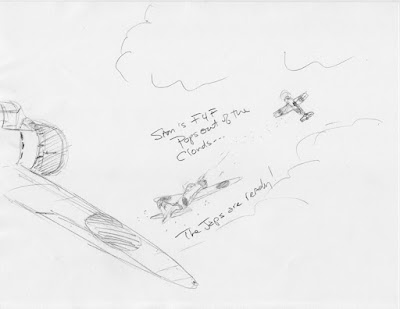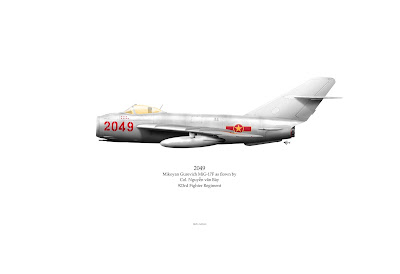Done. And it's going to take a while before my eyes can do a black airplane again. Most airplanes take me about 35 hours to do. This one clocked in at over a 100.
That's a long time to be drawing an airplane, don't you think?
You probably don't want to hear my struggles trying to get this beast to look as it should! However, recognize that "black" is a color that doesn't trifle with aspects of Light or Texture. It seems as if black's defining attribute is to blend-in rather than stand-out.
But, here it is, the PBM-3 "Mariner" that Cass Phillips flew as part of VPB-20 based in the Philippine Islands, circa late 1944.
For aviation buffs, the PBM doesn't come to mind as a WWII Navy bomber—history tends to remember the airplane as somewhat of a rescue, supply or gigantic liaison craft. Indeed, the Mariner served in all those functions. However, it was, first and foremost, a war machine.
Don't expect any photos of PBM formations, high over a target, unleashing a stick of HE onto factories or armored columns. Instead, the PBM was used more as a search-and-destroy weapon. In the case of Cass's squadron, VPB-20, the missions were characterized by hunting low and slow along coastline and river estuaries, looking for hidden Japanese freighters or patrol boats.
If you've got an imagination, picture the airplane lumbering along a tropical coastline, about 500ft off the waves, 500-1,500 feet off the beach, all eyes trained to spot anything that didn't look quite right. Of course, you're probably imagining the scene during daylight...
...however, have another look at "Barrel House Bessie" (Cass named her). Typically, PBMs were painted in the Navy's "tri-color" scheme of gray-blue, lighter gray-blue and white. Obviously, that isn't the case here. Some time in the Fall of 1944, the Navy gave the airplane a new coat of paint.
That's a long time to be drawing an airplane, don't you think?
You probably don't want to hear my struggles trying to get this beast to look as it should! However, recognize that "black" is a color that doesn't trifle with aspects of Light or Texture. It seems as if black's defining attribute is to blend-in rather than stand-out.
But, here it is, the PBM-3 "Mariner" that Cass Phillips flew as part of VPB-20 based in the Philippine Islands, circa late 1944.
 |
| PBM-3's in formation, courtesy Cass Phillips. |
For aviation buffs, the PBM doesn't come to mind as a WWII Navy bomber—history tends to remember the airplane as somewhat of a rescue, supply or gigantic liaison craft. Indeed, the Mariner served in all those functions. However, it was, first and foremost, a war machine.
Don't expect any photos of PBM formations, high over a target, unleashing a stick of HE onto factories or armored columns. Instead, the PBM was used more as a search-and-destroy weapon. In the case of Cass's squadron, VPB-20, the missions were characterized by hunting low and slow along coastline and river estuaries, looking for hidden Japanese freighters or patrol boats.
If you've got an imagination, picture the airplane lumbering along a tropical coastline, about 500ft off the waves, 500-1,500 feet off the beach, all eyes trained to spot anything that didn't look quite right. Of course, you're probably imagining the scene during daylight...
"All black?!" he remembered. "They painted my airplane all black! And of course, you know why they did that, don't you?"
"Yeah."
"That's right! We needed it to fly at night!"
Think about it—by late 1944, the Japanese were so on-the-run, the only place left to hide was in the dark. So, night-time became the time when the Japanese felt safest moving about. Warfare, of course (at least if it's 'done right') is not a 9-5 job. Well, it is...but for VPB, it meant 9pm to 5am!
Based at Tacloban, Philippines, a VPB-20 mission would begin at sunset. One can imagine the howl of the engines, the percussive banging of waves, the steady of roar of water-on-aluminum and then, at the moment of flight, a sudden smoothening, replaced with the hypnotic rumble of 3200hp droning overhead.
"We'd get up and go around the (Philippine) islands." Cass explains. "We'd be out looking for the little ships—supply, troops—and when we found them, we'd flip on the spotlight and start shooting! We'd make our first pass (with guns) and then I'd turn back around and then we'd bomb."
"And I'm assuming the Japanese kept their lights off, right?"
"Yes'sir."
"So how did you spot the ships?!"
"Well (clears his throat), that'd be where we used radar. See, we had a radar man aboard. The old radar, the kind we used in PBY's up in the Aleutians, that wasn't as good as the radar we had (in the Philippines). We'd fly along the coast lines until the guy would identify a target and we'd hit it."
"What did a ship look like (on radar)?"
"(A typical radar picture) was a line, a line that simulated the coast. That's what we'd see. And our radar operator would be able to tell if anything stood out along that coast."
"Like a ship?"
"Yes. Like a ship."
Bear in mind, those early radar scopes weren't anywhere as clear as the ones in use today. A few years ago, I saw a demonstration of what WWII-era radar screens looked like and was surprised at how crudely they displayed. They looked more like Rorschach test graphics instead of anything resembling reality. In today's instant-evolution of technology, it's easy to forget the often exhausting process that brings us to where we're at.
"That had to be an art to learn how to read those things. A skill almost..."
"It most certainly was! It was something you had to learn. By experience."
I can only imagine what it must have been like to be up there in the dark, looking for targets—their sorties certainly inspired the nickname of "Nightmare" given to the mission of the all-black PBMs. But I'm not quite sure who had the nightmare, the Japanese or the PBM's crew.
"So you'd take off at night and come back, when?"
"We'd fly all night. We'd get back around sunrise."
Though every job has its challenges, to me, the hours of instrument-flying in a black-out sdenvironment, searching for those fabled "seconds of terror" are especially awe-inspiring. Have a look at the photo below—it's a picture I took of Cass's logbook.
Check it out yourself—a crew of nine or ten, aloft for fourteen hours on three dates, thirteen hours on another. That's some serious time aloft! In comparison, a B-17 mission in the ETO was long at 8 hours.
But then again, Cass's 95 years comprise some serious time alive.
Hmmmm.
You know, if I had a dollar for every time I was asked the question, "When is your book going to be ready?" I'd be really wealthy. My answer is the same—I don't know. This all takes time. Though I really enjoy the tech and data, my real passion is for the bigger-picture story and that, as Cass knows, doesn't just happen.
I can promise this much—when I get my book ready, Cass will be in it, no doubt. In the meantime, I hope you can spare a couple minutes to listen to his thoughts on what he's learned over so long.
Come to think of it, I shouldn't complain about how long it took to get Cass's airplane done. He let me know he was glad I put the time in it to get it right.
VPB-20 bomber pilot Cass Phillips on "ageing." from John Mollison on Vimeo.
Based at Tacloban, Philippines, a VPB-20 mission would begin at sunset. One can imagine the howl of the engines, the percussive banging of waves, the steady of roar of water-on-aluminum and then, at the moment of flight, a sudden smoothening, replaced with the hypnotic rumble of 3200hp droning overhead.
 |
| Cass and Crew of "Barrel House Bessie", circa 1944. |
"We'd get up and go around the (Philippine) islands." Cass explains. "We'd be out looking for the little ships—supply, troops—and when we found them, we'd flip on the spotlight and start shooting! We'd make our first pass (with guns) and then I'd turn back around and then we'd bomb."
"And I'm assuming the Japanese kept their lights off, right?"
"Yes'sir."
"So how did you spot the ships?!"
"Well (clears his throat), that'd be where we used radar. See, we had a radar man aboard. The old radar, the kind we used in PBY's up in the Aleutians, that wasn't as good as the radar we had (in the Philippines). We'd fly along the coast lines until the guy would identify a target and we'd hit it."
"What did a ship look like (on radar)?"
"(A typical radar picture) was a line, a line that simulated the coast. That's what we'd see. And our radar operator would be able to tell if anything stood out along that coast."
"Like a ship?"
"Yes. Like a ship."
Bear in mind, those early radar scopes weren't anywhere as clear as the ones in use today. A few years ago, I saw a demonstration of what WWII-era radar screens looked like and was surprised at how crudely they displayed. They looked more like Rorschach test graphics instead of anything resembling reality. In today's instant-evolution of technology, it's easy to forget the often exhausting process that brings us to where we're at.
"That had to be an art to learn how to read those things. A skill almost..."
I can only imagine what it must have been like to be up there in the dark, looking for targets—their sorties certainly inspired the nickname of "Nightmare" given to the mission of the all-black PBMs. But I'm not quite sure who had the nightmare, the Japanese or the PBM's crew.
"So you'd take off at night and come back, when?"
"We'd fly all night. We'd get back around sunrise."
Though every job has its challenges, to me, the hours of instrument-flying in a black-out sdenvironment, searching for those fabled "seconds of terror" are especially awe-inspiring. Have a look at the photo below—it's a picture I took of Cass's logbook.
 |
| Cass Phillips logbook, VPB-20. The page is turned to November 1944. |
Check it out yourself—a crew of nine or ten, aloft for fourteen hours on three dates, thirteen hours on another. That's some serious time aloft! In comparison, a B-17 mission in the ETO was long at 8 hours.
But then again, Cass's 95 years comprise some serious time alive.
Hmmmm.
You know, if I had a dollar for every time I was asked the question, "When is your book going to be ready?" I'd be really wealthy. My answer is the same—I don't know. This all takes time. Though I really enjoy the tech and data, my real passion is for the bigger-picture story and that, as Cass knows, doesn't just happen.
I can promise this much—when I get my book ready, Cass will be in it, no doubt. In the meantime, I hope you can spare a couple minutes to listen to his thoughts on what he's learned over so long.
Come to think of it, I shouldn't complain about how long it took to get Cass's airplane done. He let me know he was glad I put the time in it to get it right.
VPB-20 bomber pilot Cass Phillips on "ageing." from John Mollison on Vimeo.
 |
| Cass Phillips, VPB-20 and Me. |




































